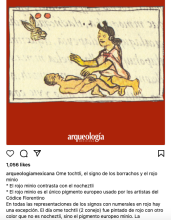Ome Tochtli (Mdz2r)
This combined simplex glyph and notation (which functions much like a compound) for Ome Tochtli (Two Rabbit, or 2-Rabbit) comprises the notation two (ome, with two ones) and the glyph of the head of a rabbit (tochtli). The rabbit is in profile looking to the viewer's right. One eye is open and teeth are visible. The ears are standing up. The ones of the notation are two small circles with a dot in the middle. This is a solar year (xihuitl) date. The original date was enclosed in a black line box (not shown here), and it is painted a turquoise color, including the background.
Stephanie Wood
A boxed-in date says this refers to a year. The turquoise watercolor wash over the date is a visual reminder that these are dates, given that the word for green or blue-green (xihuitl) is a homophone with the word for year (xihuitl). Thus, the paint could serve as a phonetic indicator for "year." Ome Tochtli (sometimes spelled Ometochtli) also refers to two deities (Izquitecatl and Tepoztecatl) associated with alcoholic beverages (such as pulque, called octli in Nahuatl) and intoxication/drunkenness. Rabbits became a symbol for pulque, as seen on a vessel that was probably used for pulque published in Wikipedia.
Ome Tochtli was also a day sign in the religious divinatory calendar, the tonalpohualli, and if one was born on that day, it may have portended that the child would grow up to be a drunkard.
Stephanie Wood
c. 1541, or by 1553 at the latest
dates, fechas, ones, numbers, números, years, años, reeds, cañas, rabbits, conejos, animales, calendarios, OmeTochtli, Ometochtli, xiuhpohualli, turquesa, xihuitl
Two Rabbit (or 2-Rabbit) could stand for a day or a year date. This image of a Two Rabbit day comes from from the Florentine Codex. It was published to Instagram on 22 August 2023. The text explains that the red color for the number two is a a lead-based red, which was a European introduction. Nocheztli (the red dye from the bugs that grow on nopalli cacti) was not used in this case. The text also mentions the association with the alcoholic beverage, pulque, and the prophecy of drunkeness.

ome, two, https://nahuatl.wired-humanities.org/content/ome
toch(tli), rabbit, https://nahuatl.wired-humanities.org/content/tochtli
Dos Conejo
Stephanie Wood
Codex Mendoza, folio 02 recto, https://digital.bodleian.ox.ac.uk/objects/2fea788e-2aa2-4f08-b6d9-648c00..., image 14 of 188.
The Bodleian Libraries, University of Oxford, hold the original manuscript, the MS. Arch. Selden. A. 1. This image is published here under the UK Creative Commons, “Attribution-NonCommercial-ShareAlike 3.0 License” (CC-BY-NC-SA 3.0).




